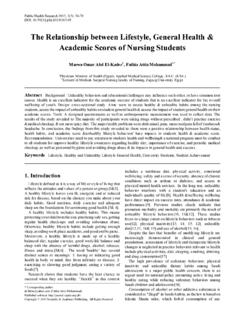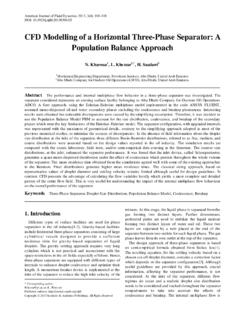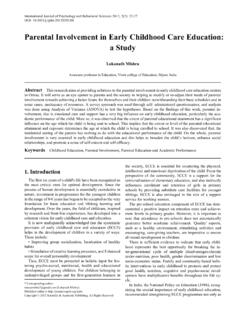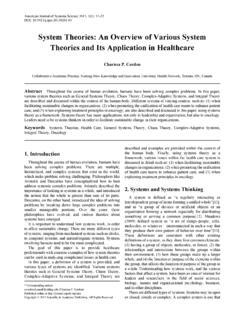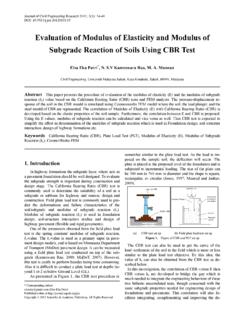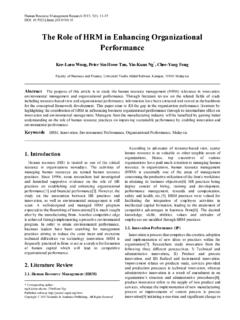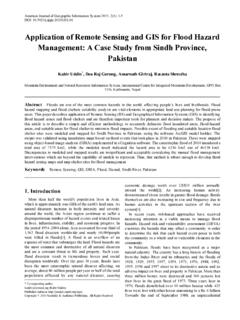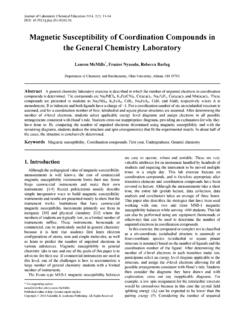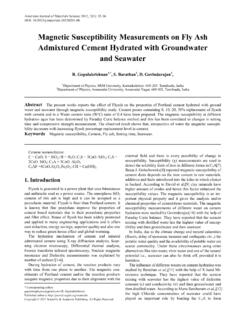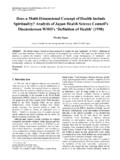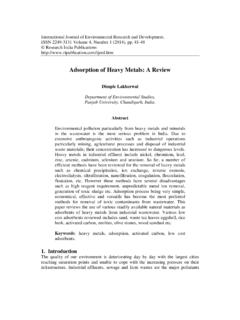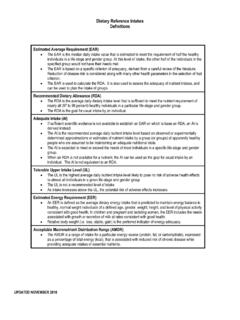Transcription of Cross-linking in Hydrogels - A Review
1 American Journal of Polymer Science 2014, 4(2): 25-31 DOI: Cross-linking in Hydrogels - A Review Jaya Maitra*, Vivek Kumar Shukla Gautam Buddha University, Greater Noida, Gautam Budh Nagar-201312 ( ), India Abstract Hydrogels represent a class of high water content polymers with physical or chemical crosslinks. Their physical properties are similar to soft tissues. Cross linking is a stabilization process in polymer chemistry which leads to multidimensional extension of polymeric chain resulting in network structure. Cross-link is a bond which links one polymer chain to other. It can be ionic or covalent. Cross linking changes a liquid polymer into solid or gel by restricting the ability of movement. When polymer chains are linked together by cross-links, they lose some of their ability to move as individual polymer chains. A liquid polymer (where the chains are freely flowing) can be turned into a solid or gel by Cross-linking the chains together.
2 Cross linking increases the molecular mass of a polymer. Cross-linked polymers are important because they are mechanically strong and resistant to heat, wear and attack by solvents. However, the drawback associated with cross-linked polymers is that they are relatively inflexible when it comes to their processing properties because they are insoluble and infusible. Keywords Hydrogels , Cross linking, Gel, Polymer 1. Introduction Hydrogels are crosslinked hydrophilic polymer structures that can imbibe large amounts of water or biological fluids. Hydrogels are one of the upcoming classes of polymer-based systems that embrace numerous biomedical and pharmaceutical applications. Because of their inherent property of biocompatibility they offer good opportunities as protein delivery systems or tissue engineering scaffolds. Their hydrophilic, soft and rubbery nature ensures minimal tissue irritation and a low tendency of cells and proteins to adhere to the hydrogel surface.
3 The use of hydrogel for biomedical applications dates back to 1960 when Wichterle and Lim developed crosslinked poly (hydroxyethyl methacrylate) (pHEMA) [1]. First synthetic Hydrogels of HEMA with EGDMA (Ethylene glycol di-methyl acrylate) as cross-linker were prepared for biological use and later used for production of contact lenses [1]. Because of their versatile and unique properties, Hydrogels have vast potential applications, including soil/water stabilization layers in farming and civil engineering structures [2], soil conditioners, controlled release of fertilizers [3,4], fiber and metallic cable sealing [5], in water technologies [6], thickening agents for cosmetics [7], in drug delivery systems [8] and in many other fields. One of the most dynamic fields in which the super-absorbent Hydrogels * Corresponding author: (Jaya Maitra) Published online at Copyright 2014 Scientific & Academic Publishing.
4 All Rights Reserved play the principle role is in the manufacture of personal care products such as feminine hygiene products, adult incontinence products and disposable diapers [9]. 2. Significance of Crosslinking Adding cross-links between polymer chains affect the physical properties of the polymer depending upon the degree of cross linking and presence and absence of crystallinity. Cross linking results in: i) Elasticity (they can stretch and return to their original form). Elastomers are elastic polymers created by limited Cross-linking . As the number of cross-links increases, however, the polymer becomes more rigid and cannot stretch as much; the polymer will become less viscous and less elastic and might even become brittle. The vulcanization or sulfur curing of rubber, for example, results from the introduction of short chains of sulfur atoms that link the polymer chains in natural rubber.
5 Bridges made by short chains of sulfur atoms tie one chain of polyisoprene to another, until all the chains are joined into one giant super molecule. The chemical process of vulcanization is a type of Cross-linking which increases the strength of rubber. It makes rubber hard and durable material associated with car and bike tires. ii) Decrease in the viscosity (the resistance to flow) of polymers. In order for polymers to flow, the chains must move past each other and Cross-linking prevents this. As a result of restriction in flow there is improvement in the creep behavior. iii) Insolubility of the polymer. Cross linking results in insolubility as the chains are tied together by strong covalent 26 Jaya Maitra et al.: Cross-linking in Hydrogels - A Review bonds. Crosslinked materials can't dissolve in solvents, but can absorb solvents. Crosslinked material after absorbing lot of solvent is called a gel.
6 For example crosslinked polyacrylamide gel. Uncrosslinked polyacrylamide is soluble in water, and crosslinked polyacrylamides can absorb water but is insoluble. Water-logged gels of crosslinked polyacrylamides are used to make soft contact lenses. iv) Increased Tg and increase strength and toughness. Crosslinking changes the local molecular packing, resulting decrease in free volume, leading to increase in Tg. PVA crosslinked with boric acid showed increased glass transition temperature [10]. Cross-links slow down the PVA molecular motion and must not be included in the crystalline domains. v) Lower melting point. For crystalline polymer with low degree of cross linking there is a decrease in the crystalline behavior, as cross linking introduces hindrance to the chain orientation resulting in softer, elastic polymer having lower melting point. vi) Transformation of therrmoplasts into thermosets.
7 Heavy Cross-linking changes thermoplasts to thermoset plastics. Once the cross-links form, the polymer s shape cannot be changed again without destroying the plastic. Unlike thermoplastic polymers, the process cannot be undone by reheating; thermoset plastics will start to decompose rather than becoming moldable and pliable. The first thermoset was polyisoprene. More the sulfur crosslinks put into the polyisoprene, the stiffer it gets. Lightly crosslinked, it's a flexible rubber. Heavily crosslinked, becomes a hard thermoset. Figure 1. Vulcanization of rubber Figure 2. Reaction of PVA with boric acid American Journal of Polymer Science 2014, 4(2): 25-31 27 3. Methods of Crosslinking Depending upon the nature of the polymer, different techniques may be used to cause cross linking. Cross-linking may occur through polymerization of monomers having functionalities more than two (by condensation) or by covalent bonding between polymeric chain through irradiation, sulphur vulcanization or chemical reactions by adding different chemicals in conjunction with heating and, sometimes, pressure.
8 In all cases, the chemical structure of the polymer is altered through the cross linking process. Cross linking by irradiation is done by using high-energy ionizing radiation, like electron beam (e-beam), gamma, or x-ray. Gamma irradiation is usually most economical at lower doses (~80 kGy and below) and for large, high density parts. Electron beam is commonly used for small parts, particularly low density parts, and in linear product processed reel to reel (eg, wire, cable, tubing). 4. Hydrogels and Crosslinking The term hydrogel represent water insoluble polymeric network that has capacity to absorb large amount of water [11-15]. A hydrogel is a macromolecular polymer gel constructed of a network of crosslinked polymer chains. They are synthesized from hydrophlic monomers by either chain or step growth, along with a functional crosslinker to promote network formation.
9 Synthetic or natural polymers, homopolymer or copolymer, are used to make three dimensional networks by molecular entanglements or by chemical crosslinking [16]. Figure 3. Cross-linking in polymer The property of Hydrogels to swell under biological conditions makes them an ideal class of materials for biomedical applications, such as drug delivery and tissue engineering [17 30]. Cross linking either physically or chemically gives hydrogel a 3D network structure, making it insoluble. This insoluble cross-linked structure allows effective immobilization and release of active agents and biomolecules. Hydrogels appear similar to natural soft tissues because of their high water content. Classification of Hydrogels : Hydrogels can be classified into physical and chemical Hydrogels based on their Cross-linking mechanism [19, 28]. Physical crosslinks include entangled chains, hydrogen bonding, hydrophobic interaction and crystallite formation.
10 These physical crosslinks may not be permanent in nature, but they are sufficient to make Hydrogels insoluble in an aqueous media. Physical crosslinking gives reversible Hydrogels . Physical Hydrogels can absorb the water but inhomogeneities or network defects may occur due to free chain ends or chain loops [29, 30]. Chemical or permanent Hydrogels are formed by covalent crosslinking of polymers [31]. One common way to create a covalently crosslinked network is to polymerize end-functionalized macromers [23, 27, 32]. Hydrogels are crosslinked with many compounds such as glutaraldehyde [33]. Some other crosslinking compounds are formaldehyde, epoxy compounds, dialdehyde [34, 35, 36]. A net-like structure along with void imperfections enhance the hydrogel's ability to absorb large amounts of water via hydrogen bonding. The type and degree of crosslinking influences many of the network properties, like swelling properties, elastic modulus and transport of molecules [37].
